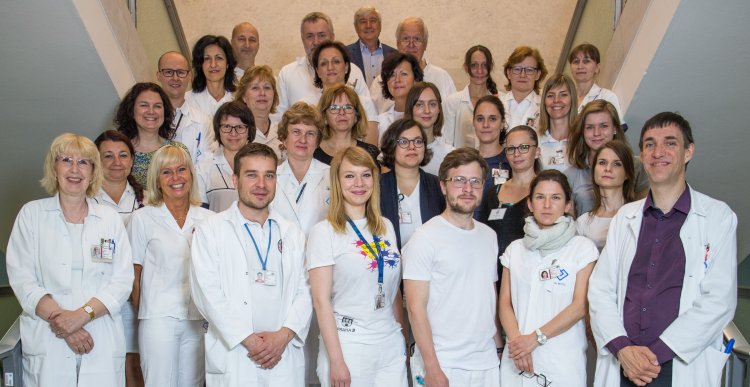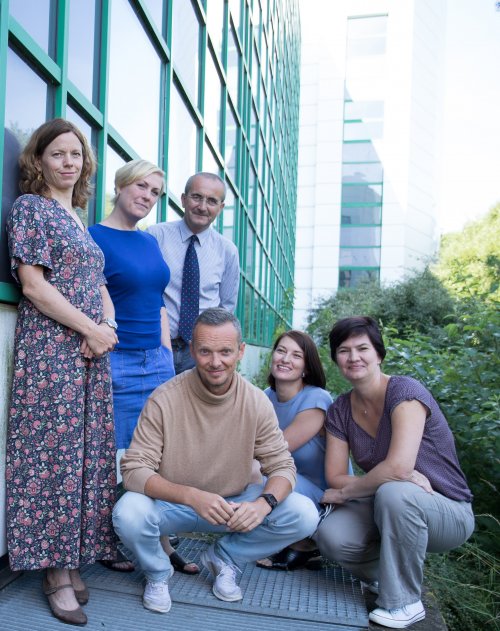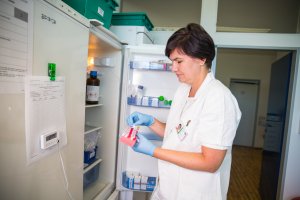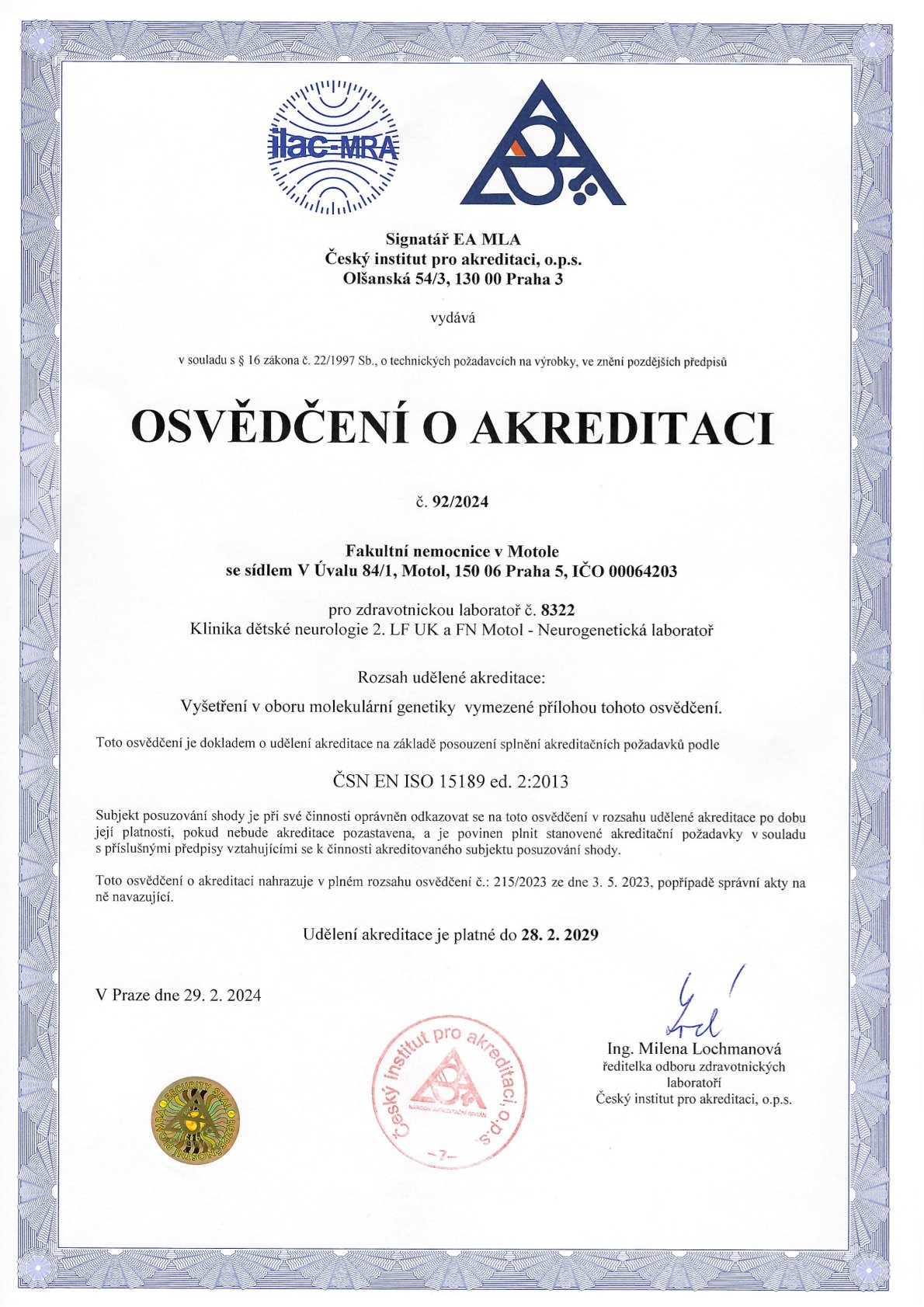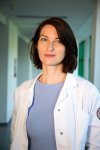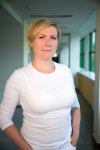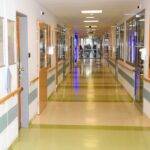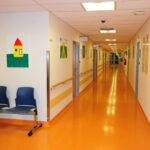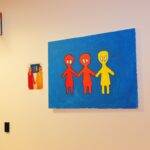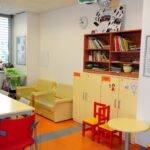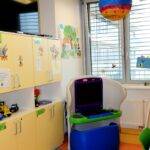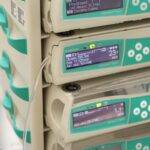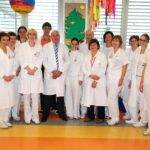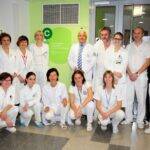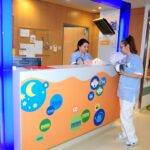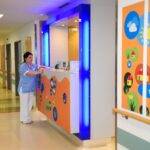- Basic information
- Management and staff
- Information for patients
- Clinic structure
- Inpatient department
- Ambulance
- Specialized ambulances
- Ambulance for botulinum toxin application and movement disorders in children
- Specialized centers
- Center for Epilepsy
- Surgical treatment of epilepsy in children
- Neuromuscular center
- Center for sleep disorders in children
- Center for Hereditary Ataxias
- Neurogenetic laboratory
- Provided examinations
- Reception of samples for laboratory examination
- Documents to download
- Accreditation certificate
- Contact
- Seminars for the professional public
- Clinic achievements
- Donation account
- Contact
- Gallery
Basic information
The Department of Pediatric Neurology of the 2nd Medical Faculty of Charles University and the Motol University Hospital is the largest institution of pediatric neurology in the Czech Republic. We provide diagnosis and treatment of children with diseases of the nervous system from 4 weeks to the age of 18 (exceptionally also to elderly patients). We try to operate as a superconsulting workplace for all neurological diagnoses of childhood throughout the Czech Republic. Some diagnostic and treatment programs (eg epileptosurgery program) also provide care to patients from abroad.
The diagnoses we deal with in our workplace include epilepsy (from childcare after the first seizure to complex interdisciplinary programs such as epileptosurgery and epileptogenetics), acute and chronic inflammatory and autoimmune diseases of the nervous system, neuromuscular diseases, neurocutaneous syndromes ( eg neurofibromatosis or tuberous sclerosis), neurodevelopmental diseases (eg cerebral palsy, developmental dysphasia), CNS developmental anomalies, suspected tumors or other expansive processes of the nervous system, vascular diseases of the brain and spinal cord, neurogenetic, neurometabolic and neurodegenerative diseases in children, non-acute post-traumatic conditions, including care for apallic children, sleep disorders.
We have two inpatient stations, including an intensive care unit of a lower type (ie without equipment for the care of patients with failure of basic vital functions). We have a total of 40 beds for patients, of which 6 beds in the ICU and 6 beds in video / EEG and printing monitoring. The clinic also includes the Electrophysiological Laboratory providing a complete spectrum of electrophysiological diagnostics in childhood (ie electroencephalography (EEG), electromyography (EMG), all evoked potential modalities (EP), intraoperative monitoring and sleep laboratory) and a DNA laboratory dealing with the diagnosis of selected genetic conditions. diseases, such as hereditary neuropathies and epileptic encephalopathies. We run a general neurological outpatient clinic and a number of specialized outpatient clinics within the polyclinic of the children's section of the Motol University Hospital. In cooperation with other workplaces of the children's section of the Motol University Hospital, our clinic provides a wide range of consulting activities.
As a university workplace, we are also intensively engaged in teaching and research activities. The clinic offers pre- and postgraduate education in several areas, including pre-certification training for pediatric neurologists. We participate in a number of scientific research projects, often within the framework of interdisciplinary and international cooperation. In recent years, our clinic has been ranked high in the evaluation of research activities of the 2nd Faculty of Medicine, Charles University and Motol University Hospital (data from 2019: 33 primary publications in journals with IF with a total IF of 167,65).
History of the clinic
The clinic was founded on January 19.1.1971, 1914 as the first independent clinical department of pediatric neurology in our country and one of the first in the world. Its founder was Professor Ivan Lesný (2002-1957), an extraordinary figure of world importance, one of the founders of the field of pediatric neurology not only in our country but also in Europe. He was one of the most talented students of the famous neurologist academician Kamil Henner. Already in 1958, he founded the Section of Pediatric Neurology at the Czechoslovak Neurological Society JE Purkyně as the first scientific organization of pediatric neurology in the world. In addition, Professor Lesný also founded the Section of Neurophysiology and the Czech League Against Epilepsy within the Czechoslovak Neurological Society. In the XNUMXs, independent professional societies of ČLS JEP were established from these sections. Already in XNUMX, he and his colleagues organized the "Days of Pediatric Neurology" for the first time, which were later established as a traditional platform for annual meetings of Czech and world neurologists.
Professor Lesný ran the clinic for 11 years (until 1982). He was succeeded by Professor Jaromír Svatý (1982), Professor Miloš Lehovský (1983-1990) and Professor Vladimír Komárek (1991-2016). Since January 2017, Professor Pavel Kršek has been running the clinic.
Among other important personalities in the history of our workplace, we will mention Associate Professor Karel Brachfeld, Associate Professor Miroslav Rössler, Mayor Pavel Kocura and Mayor Miluša Prošková. Our current team is presented on the following pages.
- Press release on the occasion of 50 years of KDN (152,35 KB)
The head
Prof. MD Pavel Kršek, Ph.D.
pavel.krsek@fnmotol.cz
Primary
Doc. MD Jana Haberlová, Ph.D.
jana.haberlova@fnmotol.cz
Head nurse
Gabriela Pavlova
gabriela.pavlova@fnmotol.cz
Secretariat - FN Motol
Alena Skrabankova, DiS.
(224) 433 301
alena.skrabankova@fnmotol.cz
Bc. Zuzana Petova
(224) 433 304
zuzana.petova@fnmotol.cz
Secretariat - 2nd Faculty of Medicine, Charles University
Renata Todtová
(224) 433 302
renata.todtova@lfmotol.cuni.cz
Management and staff
The head
Prof. MD Pavel Kršek, Ph.D.
Phone: 224 433 301, e-mail: pavel.krsek@fnmotol.cz
Deputy Head for Medical and Preventive Activities - Primary
Doc. MD Jana Haberlová, Ph.D.
Phone: 224 433 301, e-mail: jana.haberlova@fnmotol.cz
Deputy head for educational and scientific activities
MD Martin Kudr, Ph.D.
Phone: 224 433 358, e-mail: martin.kudr@fnmotol.cz
Head nurse
Gabriela Pavlova
Phone: 224 433 305, e-mail: gabriela.pavlova@fnmotol.cz
Secretariat of the Motol University Hospital
Alena Skrabankova, DiS.
Phone: 224 433 301, e-mail: alena.skrabankova@fnmotol.cz
Bc. Zuzana Petova
Phone: 224 433 304, e-mail: zuzana.petova@fnmotol.cz
Secretariat of the 2nd Faculty of Medicine, Charles University
Renata Todtová
Phone: 224 433 302, e-mail: renata.todtova@lfmotol.cuni.cz
Chief physicians of inpatient departments
Department 3C: MUDr. Lukáš Paulas
Phone: 224 433 350, e-mail: lukas.paulas@fnmotol.cz
Department 3B: MUDr. Alena Tesfaye
Phone: 224 433 374, e-mail: alena.tesfayeova@fnmotol.cz
Chief Physician of the Intensive Care Unit (ICU)
MD Miroslav Maminák
Phone: 224 433 3357, e-mail: miroslav.maminak@fnmotol.cz
Chief Physician of the Electrophysiology Laboratory
MUDr. Katalin Štěrbová
Phone: 224 433 369, e-mail: katalin.sterbova@fnmotol.cz
Chief ambulance doctor
MD Renata Cíbochová
Phone: 224 433 834, e-mail: renata.cibochova@fnmotol.cz
Chief Physician of the Neurogenetic Laboratory
Phone: 224 436 789, e-mail: petra.lassuthova@fnmotol.cz
Doctors:
Doctors specializing
MD Anežka Bělohlávková, Ph.D., e-mail: anezka.belohlavkova@fnmotol.cz
MUDr. Matthias Ebel, e-mail: matyas.ebel@fnmotol.cz
MD Ludvíka Faladová, e-mail: ludvika.faladova@fnmotol.cz
MD Petra Fuchsová, maternity leave
Doc. MD Jana Haberlová, Ph.D., E-mail: jana.haberlova@fnmotol.cz
MD Alena Jahodová, Ph.D., e-mail: alena.jahodova@fnmotol.cz
Prof. MUDr. Vladimir Komarek, CSc., E-mail: vladimir.komarek@fnmotol.cz
MUDr. Josef Kraus, CSc., E-mail: josef.kraus@fnmotol.cz
MD Zuzana Libá, Ph.D., e-mail: zuzana.liba@fnmotol.cz
MD Michaela Lifková, e-mail: michaela.lifkova@fnmotol.cz
MUDr. Miroslav Mamanak, e-mail: miroslav.maminak@fnmotol.cz
MUDr. Katerina Paderova, e-mail: katerina.paderova@fnmotol.cz
MD Ivana Perníková, e-mail: ivana.pernikova@fnmotol.cz
MUDr. Bořivoj Petrák, CSc., E-mail: borivoj.petrak@fnmotol.cz
MD Jana Pokorná, e-mail: jana.pokorna@fnmotol.cz
MD Věra Sebroňová, email: vera.sebronova@fnmotol.cz
MD Lucie Šimková, maternity leave
MD Rosa Vydrová, e-mail: rosa KVKrova@fnmotol.cz
MD Alena Zumrová, Ph.D., e-mail: alena.zumrova@lfmotol.cuni.cz
MD Anežka Žáková, e-mail: anezka.zakova@fnmotol.cz
MD Marie Bartoníčková, e-mail: marie.bartonickova@fnmotol.cz
MD Jonáš Boruta, e-mail: jonas.boruta@fnmotol.cz
MD Anežka Dolanská, e-mail: anezka.dolanska@fnmotol.cz
MD Michal Gloser, e-mail: michal.gloser@fnmotol.cz
MD Markéta Kumhera, e-mail: marketa.kumhera@fnmotol.cz
MD Barbora Lauerová, e-mail: barbora.lauerova@fnmotol.cz
MD Ludmila Novotná, e-mail: ludmila.novotna@fnmotol.cz
MD Richard Retamoza, email: richard.retamoza@fnmotol.cz
MD Marie Rohlenová, e-mail: marie.rohlenova@fnmotol.cz
MD Barbora Splítková, e-mail: barbora.splitkova@fnmotol.cz
MD Anna Svěráková, e-mail: anna.sverakova@fnmotol.cz
MD Diana Štefanková, e-mail: diana.stefankova@fnmotol.cz
MD Lucie Šťovíčková, e-mail: lucie.stovickova@fnmotol.cz
MUDr. Tomas Toman, e-mail: tomas.toman@fnmotol.cz
MD Martin Tůma, e-mail: martin.tuma@fnmotol.cz
RNDr. Jan Jencik, e-mail: jan.jencik@lfmotol.cuni.cz
Ing. Lucie Sedlackova, Ph.D., e-mail: lucie.sedlackova@lfmotol.cuni.cz
MD Barbora Straka, Ph.D., e-mail: barbora.straka@fnmotol.cz
prof. MD Pavel Seeman, Ph.D., e-mail: pavel.seeman@lfmotol.cuni.cz
Ing. David Stanek, Ph.D., e-mail: david.stanek@lfmotol.cuni.cz
MUDr. Dana Safka Brozkova, Ph.D., e-mail: dana.brozkova@lfmotol.cuni.cz
RNDr. Anna Uhrová Mészárosová, Ph.D., e-mail: anna.meszarosova@lfmotol.cuni.cz
Information for patients
Ambulance
The outpatient clinic of the Children's Neurology Clinic is located on the 3rd floor, node E (polyclinic building).
If you want to book your child to one of our clinics (general, specialized, within one of the centers) and this is not an urgent case, it is necessary to submit a recommendation from a pediatrician or pediatric neurologist from the place of residence. We order on working days preferably at the following times: 7:30-8:00, 9:30-11:00 and 14:00-15:00
If you cannot reach this phone at the moment, the nurses are attending to other patients. Even in non-urgent cases, when ordering, we try to take into account the urgency and possible risks of postponing the examination, however, the average appointment time for our clinics is currently 3-4 months. Priority is given to patients requiring center care, which is not available outside the FN Motol. If a routine examination by a pediatric neurologist is indicated (e.g. due to specific learning disorders, hyperactivity, etc.), we recommend contacting a pediatric neurology clinic at the place of residence. Thank you for your understanding!
If your child is already monitored with us, you can use our email address for ordering and further communication ambulance.kdn@fnmotol.cz. It is always necessary to state the name of the patient, his year of birth and clearly formulate your request (e.g. date of outpatient check-up, reorder, sending prescription, etc.). The nurse will always reply to such an email. This e-mail address is not intended for consulting the health status of children who are not under long-term follow-up at our clinic!
Hospitalization
We have 2 fully renovated ones available inpatient wards.
Contact to nurse 3.B: 224 433 335
Contact to nurse 3.C: 224 433 334
With any questions about planned hospitalizations contact the clinic secretariat on phone no. (224) 433 301, if it is a case of hospitalization with video EEG, contact the laboratory staff at phone no. (224) 433 360.
We accept patients for planned hospitalization on the basis of a written recommendation from a pediatrician or a pediatric neurologist at the place of residence. Every request for hospitalization at the Pediatric Neurology Clinic is carefully assessed by a qualified doctor who will determine the priority of this request. Priority is given to children with acute or progressive problems and also with a disease that requires highly specialized (center) care, which is not available in other pediatric neurology inpatient departments in the Czech Republic. We would like to point out that due to the large number of requests it can be the waiting time for hospitalization for patients with non-acute problems is even more than 3 months. Thank you for your understanding.
About the date of hospitalization you will be informed by our secretariat, usually in the form of a letter sent to your home address approximately 1 month before the planned reception.
Length of hospitalization depends entirely on the needs of the specific case (it is tailored to the child's diagnostic and treatment program). Parents will receive more detailed information about the stay at the clinic during the intake interview with the doctor.
Hospitalization of the accompanying child in the ward is possible up to 6 years of age of the child, or with a ZTP card holder, if the clinic's current operational capabilities allow. Other parents can use the dormitory on the hospital premises for an overnight stay (no reservation required).
We do not have superior rooms or studios available, a child with a possible escort is accepted into a 2-3 bed room, mostly with its own bathroom.
Detailed information (e.g. what to take with you to hospital) you will find <a href="https://cdn.shopify.com/s/files/1/1932/8043/files/Odstoupeni_od_smlouvy_EN.pdf?v=1595420299" data-gt-href-en="https://en.notsofunnyany.com/">HERE</a> or on a written invitation sent together with the date of admission to the parents' address. If necessary, there is a pharmacy, medical supplies, grocery store, hot snacks, or vending machines in the hospital complex.
Electrophysiological laboratory
If you are ordered for an examination in an electrophysiological laboratory and you would not be able to come by the given deadline, re-ordering is possible on the number (224) 433 360.
You can find information for children from Slovakia and other foreigners <a href="https://cdn.shopify.com/s/files/1/1932/8043/files/Odstoupeni_od_smlouvy_EN.pdf?v=1595420299" data-gt-href-en="https://en.notsofunnyany.com/">HERE</a>
You can find information for parents of children invited as part of the epilepsy surgery program <a href="https://cdn.shopify.com/s/files/1/1932/8043/files/Odstoupeni_od_smlouvy_EN.pdf?v=1595420299" data-gt-href-en="https://en.notsofunnyany.com/">HERE</a>
You can find information for parents of children invited to be examined in the sleep laboratory <a href="https://cdn.shopify.com/s/files/1/1932/8043/files/Odstoupeni_od_smlouvy_EN.pdf?v=1595420299" data-gt-href-en="https://en.notsofunnyany.com/">HERE</a>
Clinic structure
Standard ward - 3rd floor B
18 standard beds (DNS2 station)
Department description:
- 1x 2-bed room
- 4x 3-bed room
- 2x 1-bedded and 1x 2-bedded room for video / EEG and printing monitoring
Standard ward - 3rd floor C
16 standard beds (DNS1 station) + 6 lower ICU beds including 1 heated bed (DNJ station)
Department description:
- 1x 2-bedded room, 2x 4-bedded room, 2x3-bedded room
- 2x 2-bedded room for ICU patients
- 1x 2-bedded room video / EEG
Electrophysiological Laboratory - 3rd floor D
- 2x EEG examination room
- 2x EMG examination room
- 1x examination room of evoked potentials
- 1x description and archive of EEG records
Ambulance - 3rd floor E
- 4x outpatient room - see Ambulance.
Complement - 3rd floor D
- offices of the clinic management and doctors, secretariat, library.
Complement - 10th floor C
- medical rooms
Neurogenetic laboratory - pavilion 23
Inpatient department
Standard ward - 3rd floor B
Chief doctor
MUDr. Alena Tesfaye
Station nurse
Simona Pepíchová
Location
Children's bed part, 3rd floor, node B
Contact sister
Tel: 224 433 335
Standard ward - 3rd floor C
Chief doctor
MD Lukas Paulas
Station nurse
Pavlína Kuhnová
Location
Children's bed part, 3rd floor, node C
Contact sister
Tel: 224 433 334
Intensive Care Unit
Chief doctor
MD Miroslav Maminák
Location
Children's bed part, 3rd floor, node C
Department equipment
There is a fridge for patients and their companions in the playroom to store their own food. Food must be marked with the child's name. Labels are available on the refrigerator. For free use, there is a microwave and permanently brewed fruit tea.
Patients and their companions are not allowed to enter the ward kitchens for hygienic reasons. There is a refrigerator in the kitchen for storing dairy food. There is also a waitress who heats her coffee water for her parents on request. Only patients who have been prescribed a special ketogenic diet may enter the kitchen and prepare it there. Special aids for the preparation of this diet are available in the cabinet (weight on a spoon with an accuracy of 0,1 g, etc.).
The department has, among other things, a pram and sports pram - golf carts, chairs for feeding toddlers, plastic trays, toilet seats and potties.
Ambulance
Contact: Tel .: 224 433 834
Chief doctor
MD Renata Cíbochová
General ambulance doctors
MD Renata Cíbochová
MD Ivana Perníková
MD Bořivoj Petrák, CSc.
MD Lukas Paulas
MD Kateřina Paděrová
Station nurse
Tatiana Ružičková
Location
Children's Polyclinic Part, 3rd floor, node E (moved from 25.3.2019)
Office hours
Monday to Friday, 8.30 am - 15.30 pm
The examination of the last patient is started at 15.00 pm.
The outpatient clinic of the Children's Neurology Clinic is located on the 3rd floor, node E (polyclinic building).
K ordering new patients In most of our outpatient clinics, the recommendation of a pediatrician or pediatric neurologist from place of residence. We order exclusively on the telephone number (224) 433 834 on weekdays, preferably from 9:30 to 10:30 and from 14:00 to 15:00. If you can't call this phone right now, the nurses are paying attention to other patients. Thank you for your understanding!
K ordering patients who have already been treated with us use our email address ambulance.kdn@fnmotol.cz, where it is always necessary to state the patient's name, year of birth and the given request (eg date of ordering the check, re-order, sending the prescription…, etc.). The nurse will always answer your email.
Acute ambulance operates every working day from 8:00 a.m. to 15:30 p.m. Examination of the last patient begins at 15:00 p.m. Patients who arrive outside of this time are treated at the First Aid Medical Service located on the lower ground floor. LSPP operation is continuous.
Specialized ambulances
We order to specialized clinics on the basis of a recommendation from a pediatric neurologist from the place of residence or according to a recommendation from hospitalization at our clinic. For more information, call 224 433 834.
Epilepsy clinic
prof. MD Pavel Kršek, Ph.D.
prof. MUDr. Vladimir Komarek, CSc.
MUDr. Věra Sebroňová
MD Katalin Štěrbová
MD Martin Kudr, Ph.D.
MD Alena Jahodová, Ph.D.
MD Anežka Bělohlávková, Ph.D.
Ambulance for sleep disorders in children
MD Katalin Štěrbová
MUDr. Alena Tesfaye
Counseling for high-risk newborns and infants
MD Renata Cíbochová
Counseling for neuromuscular diseases
doc. MD Jana Haberlová, Ph.D.
MD Margareta Kumhera
MD Barbora Lauer
MD Marie Rohlenová
MD Michael Gloser
Ambulance for botulinum toxin application and movement disorders in children
MD Josef Kraus, CSc.
Counseling for inflammatory and demyelinating diseases
MD Zuzana Libá, Ph.D.
Neurooncology clinic
MD Ivana Perníková
Neurohematology outpatient clinic
MD Jana Pokorná
Counseling for neurocutaneous diseases
MD Bořivoj Petrák, CSc.
Ambulance for neurometabolic and neurodegenerative diseases
MUDr. Alena Zumrova, Ph.D.
Psychological and neuropsychological counseling
Mgr. Alice Maulis
M.Sc. Jitka Venclová-Žáčková
Neurogenetic clinic
Prof. MD Pavel Seeman, Ph.D.
Ambulance for botulinum toxin application and movement disorders in children
The outpatient clinic provides follow-up care for patients for whom the necessary diagnostics and therapy of movement disorders cannot be performed in regional workplaces. We primarily deal with the treatment of spasticity, but also extrapyramidal diseases and other movement disorders in childhood. We offer comprehensive diagnostics using the clinical experience of our department, the equipment of the Electrophysiological Laboratory of the Department of Pediatric Neurology, as well as interdisciplinary cooperation with a number of clinical and laboratory departments of the University Hospital in Motol. Patients with difficult-to-resolve movement disorders are discussed at regular interdisciplinary seminars of the NORA team, which are attended by specialists from a number of fields (pediatric neurologists, orthopedists, rehabilitation physicians, physiotherapists, occupational therapists, etc.). We provide pharmacological treatment, including an indication of special procedures such as intrathecal application of baclofen (baclofen pump implanted by colleagues at the Department of Neurosurgery for Children and Adults, 2nd Medical Faculty, Charles University and Motol University Hospital). We perform botulinum toxin applications and recommend indications for orthopedic corrections and functional neurosurgical procedures. We indicate specialized rehabilitation, physiotherapy, occupational therapy and speech therapy and work closely with the children's ward Departments of Rehabilitation and Sports Medicine, 2nd Faculty of Medicine, Charles University and Motol University Hospital.
Chief physician:
MD Josef Kraus, CSc.
Ambulance contact: 224 433 834
Specialized centers
Centers recognized by the Ministry of Health of the Czech Republic
Motol Epilepsy Center (Highly specialized care center for drug-resistant epilepsy)
Chief physician:
Prof. MD Pavel Kršek, Ph.D., e-mail: pavel.krsek@fnmotol.cz
Centers with international accreditation within the European Reference Network for Rare Diseases (European Reference Network - ERN)
ERN for rare and complex epilepsy (ERN EpiCARE)
Leading doctors:
Prof. MD Pavel Kršek, Ph.D., e-mail: pavel.krsek@fnmotol.cz;
MD Katalin Štěrbová, e-mail: katalin.sterbova@fnmotol.cz
ERN for rare neuromuscular diseases (ERN NMD)
Chief physician:
MD Jana Haberlová, Ph.D., e-mail: jana.haberlova@fnmotol.cz
Center for Hereditary Ataxias in ERN Rare Neurological Diseases (ERN RND)
Chief physician:
MD Alena Zumrová, Ph.D., e-mail: alena.zumrova@lfmotol.cuni.cz
Centers recognized by the professional company ČLS JEP
Center for sleep disorders in children
Chief physician:
MD Katalin Štěrbová, e-mail: katalin.sterbova@fnmotol.cz;
MD Alena Tesfayeová, e-mail: alena.tesfayeová@fnmotol.cz
Center for Epilepsy
The Motol Center for Epilepsy is a specialized workplace that provides comprehensive diagnostic and medical care for the entire spectrum of pediatric and adult patients with epilepsy. The center is based on close cooperation between the Department of Pediatric Neurology and the Department of Neurology of the 2nd Medical Faculty of Charles University and the Motol University Hospital. Patients are examined and treated in the relevant clinics, complicated cases and especially patients with drug-resistant epilepsy are discussed in joint seminars.
Our vision is to provide patients with the most severe forms of epilepsy with world-class care. We deal with the whole spectrum of childhood epileptic syndromes, specifically we deal with the issue of surgical treatment of epilepsy (epileptosurgical program) and identification of genetic causes of the disease (epileptogenetic program). We provide care to pediatric patients from all over the Czech Republic, and in indicated cases also to children from Slovakia and other European countries. Our patients are also systematically monitored in an epilepsy clinic.
Our diagnostic and treatment procedures meet all internationally recognized criteria. In 2008, the Motol Center for Epilepsy received the international accreditation of the European Academy of Epilepsy (EUREPA), in 2015 the Ministry of Health of the Czech Republic granted it the status Highly specialized care centers for drug-resistant epilepsy, since 2017 we have been part of the European Reference Network for rare and complex epilepsy (ERN EpiCARE).
The Department of Pediatric Neurology has six beds of video / EEG and polygraphic monitoring, including a 256-channel system for long-term invasive monitoring from intracranial electrodes. Cooperation with other specialist workplaces within the University Hospital in Motol and some extramural clinics then provides our patients with access to a complete range of diagnostic and treatment procedures at the best world level. We work closely with, for example, the Department of Pediatric and Adult Neurosurgery, 2nd Faculty of Medicine, Charles University and Motol University Hospital, Department of Imaging Methods, 2nd Faculty of Medicine, Charles University and University Hospital Motol, Department of Nuclear Medicine and Endocrinology, 2nd Faculty of Medicine, Charles University and Motol University Hospital, Department of Biology and Medical Genetics, 2nd Faculty of Medicine, Charles University and FN Motol, Department of Pathology and Molecular Medicine, 2nd Faculty of Medicine, Charles University and FN Motol, Department of Clinical Psychology, Motol University Hospital, PET Center, Na Homolce Hospital, MR Department, IKEM or the Department of Stereotactic and Radiation Neurosurgery, Na Homolce Hospital.
In addition to patient care, the Motol Center for Epilepsy forms an educational and research base for epilepsy. Individual physicians participate in undergraduate and postgraduate teaching in the areas of epileptology and EEG. We offer consulting and training activities for regional epileptologists and other epileptological workplaces in the Czech Republic and abroad. We participate in a number of interdisciplinary and international research projects, the output of which has been a number of publications and prestigious awards.
In 2018, the Epilepsy Research Center Prague was established (EpiReC) as a partnership of the 2nd Faculty of Medicine, Charles University, the University Hospital in Motol, the Institute of Physiology of the ASCR and the Faculty of Electrical Engineering of the Czech Technical University). It is a unique platform that connects top doctors from the Motol Center for Epilepsy in the field of epileptological research with excellent scientists from the Academy of Sciences of the Czech Republic and data processing experts from the Czech Technical University. The purpose of EpiReC is to participate in setting new global directions in the research and treatment of epilepsy, to facilitate the transfer of scientific knowledge from the laboratory to clinical practice and, as a result, to improve and streamline patient care.
Doctors:
Prof. MD Pavel Kršek, Ph.D.
Prof. MUDr. Vladimir Komarek, CSc.
MD Katalin Štěrbová
MD Martin Kudr, Ph.D.
MD Alena Jahodová, Ph.D.
MUDr. Barbora Benova, Ph.D.
MD Anežka Bělohlávková, Ph.D.
MUDr. Bc. Matthias Ebel
MD Barbora Splitková
Surgical treatment of epilepsy in children
A few words of introduction
Surgical treatment of epilepsy (so-called epileptosurgery) is a modern treatment option for patients suffering from uncontrollable epilepsy. This is a complex issue that is the subject of a number of misconceptions and myths. As the Department of Pediatric Neurology of the 2nd Medical Faculty of Charles University and the Faculty of Medicine and within the Motol Center for Epilepsy are intensively involved in the issue of difficult-to-manage epilepsy, we offer brief information about epileptosurgery here. It aims to clarify the basic principles and concepts and motivate for a more detailed discussion of the topic with any of the qualified doctors.
Today, epileptosurgery includes a wide range of procedures ranging from various types of brain surgery to some neurostimulation procedures. Resection (ie surgical removal of part of the brain tissue) or disconnection (ie disconnection of the affected part of the brain, eg so-called hemispherotomy) are considered curative (ie able to causally cure epilepsy). Neurostimulation procedures (ie chronic stimulation of the peripheral or central nervous system) are indicated as palliative (ie they are not expected to cure epilepsy, but alleviate its manifestations). Of these, only vagus nerve stimulation (vagal stimulator, VNS) is used in children today.
Unmanageable (drug-resistant) epilepsy
Simply put, it is a form of epilepsy in which seizures occur despite proper anti-epileptic treatment and adherence to the principles of an anti-seizure lifestyle. The International League Against Epilepsy (ILAE) has defined drug-resistant epilepsy as unsatisfactory seizure compensation after trying 2 correctly selected and dosed antiepileptic drugs, across patient age groups. Like epilepsy itself, uncontrollable epilepsy has a number of causes that can be congenital or acquired. He also has a number of speeches; in addition to the various types of seizures, there are also associated patient health problems, which we will mention below.
Unfortunately, drug-resistant epilepsy is not exceptional. With an incidence of epilepsy in the population of 0.5-1% (rather 1% in children), we reach the number of 60.000.000 patients in the world and about 80.000 in the Czech Republic; 20.000 of these patients are children under 18 years of age (with the number of children 2.075.421 in the Czech Republic; Statistical Yearbook 2015). Despite advances in the pharmacological treatment of epilepsy, the proportion of drug-resistant patients has long been about 30%; in the Czech Republic, 25.000 people, of which at least 6.000 children with uncontrollable epileptic seizures.
Risks of uncontrollable epilepsy
Virtually every patient with uncompensated epilepsy has a number of health problems. It is therefore not exclusively the presence or absence of seizures. Risks of prolonged drug-resistant epilepsy include higher mortality (eg risk of sudden death in patients with epilepsy - SUDEP), more frequent injuries, cognitive (mental) and psychiatric disorders, the burden of repeated hospitalizations, side effects of treatment, but also exclusion from treatment. collective (so-called stigma). Especially in young children, frequent seizures can seriously disrupt the overall psychomotor development.
If epilepsy cannot be managed with medication, epileptosurgery should be considered due to the risks of associated complications. This is a specific issue that is dealt with exclusively by specialized centers recognized by the Ministry of Health of the Czech Republic (so-called centers of highly specialized care for drug-resistant epilepsy). In the Czech Republic, these are the Motol Center for Epilepsy, the Brno Center for Epilepsy and the Homolka Hospital Center for Epilepsy. The first two of them also deal with the diagnosis and treatment of pediatric patients.
Basic principles of surgical treatment of epilepsy
It should be emphasized at the outset that not every patient with uncontrollable seizures is indicated for an epileptosurgery. Unfortunately, for most, it turns out that surgical treatment would have no chance of success or would be associated with too great risks. However, even with this fact, we try to follow the rules that every patient with drug-resistant epilepsy should be examined at least once in a center for epilepsy. Even if an epileptosurgical solution cannot be designed, medication adjustment or psychological and social counseling can often be of great help.
It is always necessary to first verify that the patient actually suffers from drug-resistant epilepsy. This is because some patients may actually have non-epileptic seizures or may have so-called "pseudopharmacoresistance", ie insufficient compensation of seizures due to improper management or insufficient patient cooperation in treatment.
If a patient is found to have drug-resistant epilepsy and may be a candidate for epileptosurgery, they must undergo more complementary examinations to determine if epileptosurgery can be performed, specify the type of operation, its chances of success, and, of course, the risks involved. The main goals of preoperative diagnosis include determining the cause of epilepsy, determining the area of the brain responsible for seizures, and whether this area is removable (or detachable) without unacceptable neurological and / or psychological consequences.
The conclusion of preoperative diagnosis is a proposal of a procedure that the patient (legal representative for children) may or may not accept. With few exceptions, epileptosurgery is not a life-saving operation. These are performances that aim to improve the quality of life. There are also certain risks involved in each of them. If the patient or his parents are not willing to accept these risks, they will in no way be forced to address the operation.
What tests must the patient undergo before the operation?
The attending physician proposes a "tailor-made" program of preoperative examinations for each patient. Therefore, it is definitely not the case that every patient must undergo all available diagnostic tests. It depends on the nature of the disease, the specific questions we ask ourselves before the operation, but also on the age of the child and his ability to cooperate in some examinations.
There are a number of tests available today that can be divided into electrophysiological (ie, examining the electrical activity of brain tissue), neuroimaging (ie, showing the structure and possibly some functions of brain tissue) and neuropsychological examinations. They are further divided into non-invasive (ie non-intracranial) and invasive examinations (special intracranial electrodes are used - see below). Of course, we always proceed from examinations of less burdensome (non-invasive) to more burdensome tests.
This text does not provide a detailed analysis of the nature and manner of individual examinations; only a brief list will follow. You will be continuously informed by the attending physician about the reasons for the indication and the details of performing individual diagnostic tests. For most tests, there are detailed informed consents to the examination; in detail we refer to more detailed publications.
From electrophysiological examinations, each candidate undergoes surgical treatment of epilepsy video / EEG monitoring , ie long - term recording of electrical activity of the brain (EEG) together with video recording of its behavior. The main goal of video / EEG is to capture epileptic seizures. If the long-term frequency of seizures is not sufficient to realistically detect them during monitoring, we must reduce the doses of antiepileptic drugs in indicated cases. This is done exclusively in specialized centers with trained staff able to intervene effectively in the event of an acute situation. Standard video / EEG monitoring is performed from scalp electrodes, ie electrodes placed on the surface of the head. Monitoring using intracranial electrodes is a very specific examination that we will discuss below.
The basic imaging examination is magnetic resonance (MR) of the brain, ie depiction of its anatomical structure. It should be emphasized that patients with drug-resistant epilepsy should be examined with a specific MR protocol different from that of patients with other neurological diagnoses, which may be more time-consuming than conventional MR examination.
Functional magnetic resonance imaging (fMR) is a method based on the MR principle, enabling non-invasive mapping of some functions of the cerebral cortex (eg centers of momentum, speech, vision, etc.). The condition is the active cooperation of the patient during the examination.
Magnetic Resonance Spectroscopy (MRS) is an examination that can detect the concentration of some functionally important metabolic compounds in brain tissue in a non-invasive way; it can thus help to clarify the nature and extent of the pathological tissue.
Tractography (DTI) is another examination on the principle of MR (specifically diffusion measurement) enabling the display of individual neural connections (tracts). It can be of great importance in detailed operational planning.
Positron emission tomography (PET) is a radioisotope examination of brain tissue metabolism. In patients with focal epilepsy, decreased metabolism usually appears in the affected area.
Single Photon Emission Computed Tomography (SPECT) is another radioisotope method that detects changes in blood flow to the brain. In patients with epilepsy, the so-called ictal SPECT, consisting in intravenous administration of a radiopharmaceutical directly during an epileptic seizure, is of major importance. This is a relatively demanding examination performed exclusively during video / EEG monitoring, which in some patients allows to locate the area of the onset of seizures.
Neuropsychological tests are an integral part of preoperative examinations. They should be performed by an erudite neuropsychologist with experience in epileptological issues. Each patient is subsequently monitored neuropsychologically even after epileptosurgery.
What types of epilepsy can be treated with brain surgery?
In principle, these are all diseases on the basis of which part of the brain tissue has been or is being damaged, which is then the source of epileptic seizures and at the same time can be removed by neurosurgery. Congenital factors (eg genetic or external stimuli caused by cortical development during pregnancy, brain damage during childbirth or various acquired brain tissue injuries (eg head injuries, tumors, inflammation, vascular diseases) can cause such brain damage.
We will mention only a few of the most common causes of focal epilepsy in childhood. The leading cause of focal epilepsy is disorders of the cortex. Focal cortical dysplasias predominate in pediatric epileptosurgical files (more than 40% of all pediatric resections and up to 75% of children operated on up to 2 years of age), but some extensive developmental defects such as hemimegalencephaly are surgically solvable.
The second most common cause of epileptosurgery in childhood is benign brain tumors (most often these are developmental, ie pre-natal tumors; about 20% of child resections). Furthermore, we will mention some neurocutaneous syndromes (tuberous sclerosis and Sturge-Weber syndrome), hypothalamic hamartoma and certain vascular damage to the brain tissue. On the contrary, the so-called hippocampal sclerosis (scar tissue in the inner part of the temporal lobes; the most common pathological finding in adult epileptosurgical files) occurs only in childhood (only about 5% of pathological findings in children's groups) and its incidence is constantly decreasing.
What surgical procedures are being performed today?
We choose a completely individual surgical procedure for each patient on the basis of all available information. It is an exaggeration to say that no two children operated on for epilepsy will undergo the same procedure. The location and scope of the operation differ significantly between individual cases, which fundamentally affects the chances of performance and the resulting risks.
The choice of types of surgical procedures also corresponds to the different spectrum of surgically treatable epilepsy in children. Less frequently than in adults, so-called standardized procedures are indicated (eg anteromezial temporal resection in patients with temporal lobe epilepsy). The extent of resections varies dramatically from small targeted procedures through the removal of one or more brain lobes to operations with a hemispherical extent. For the latter (indicated, for example, for extensive vascular damage of one hemisphere, some disorders of cortical development or Rasmussen's encephalitis), we today prefer disconnection of the affected hemisphere (disconnection, so-called hemispherotomy) over extensive resection (ie anatomical hemispherectomy); the reason is the lower burden on patients with postoperative complications.
From the point of view of preoperative preparation, it is important to divide epileptosurgical procedures into so-called one-time, in which we proceed directly to brain surgery and the so - called. two-term performances, where the so - called invasive video / EEG monitoring precedes the actual operational solution. In two-stage procedures, intracranial electrodes are first introduced neurosurgically, which are used to accurately map the source of epileptic seizures and to determine in detail the location of some functionally important brain centers. Intracranial electrodes can be placed on the surface of the brain (so-called subdural electrodes) or inserted directly into brain tissue (so-called intracerebral electrodes).
Between invasive video / EEG indication discrepancies between the results of non-invasive tests, normal MR findings, a presumed wider extent of epileptogenic tissue than the displayed pathology on MR, or a close relationship between the onset of seizures and important cortical centers. The proportion of patients examined in this way varies considerably between epileptosurgery centers; in children's files it is most often around 20% of cases.
Invasive video / EEG monitoring lasts approximately 1-2 weeks. The patient is hospitalized on a video / EEG monitoring unit in a similar mode as for monitoring from scalp electrodes; his head is covered with a sterile bandage. Subsequently, based on the detailed information obtained in this way, it is decided whether to follow the actual brain surgery.
What is the probability of success of epileptosurgery?
The likelihood that a patient will be seizure-free after surgery is affected by many factors and must be quantified separately for each patient. You can never give a 100% guarantee of success in advance. On average, 60-70% of children undergoing various resections 1-2 years after surgery are completely seizure-free. The chances of individual patients for postoperative seizures depend mainly on the cause of the disease (it is better in benign tumors than in larger cortical disorders), type of operation (better in hemispherotomy than in multilobar resection) or duration of epilepsy before surgery (better in early indicated patients).
Importantly, the success of the operation cannot be limited to the question of the presence or absence of seizures. We increasingly see seizure compensation as a "mere" means of improving the overall quality of life of sick children. These are, for example, involvement in society, the possibility of education or employment. The possibility of achieving such goals is completely individual and should be discussed before the operation.
What are the risks of brain surgery?
The experience of many epileptosurgery centers shows about 1% risk of death and 5% risk of long-term consequences due to unforeseen complications during resection. These complications can be bleeding, bleeding, or swelling or infection. The specific risks depend entirely on the nature of the child's illness and the type of operation chosen. We can already effectively prevent most complications, but the risk of unforeseen problems in brain surgery will probably never be completely zero. In any case, the operations team must be convinced that the risks of the proposed operation do not exceed the potential benefits.
Palliative epileptosurgery in children
These are methods that, in most patients, do not lead to full seizure compensation, but only to some improvement. It has already been stated that of the neurostimulation procedures, only vagus nerve stimulation (vagal stimulator, VNS) is currently used in children. It is a pacemaker-like device that is placed subcutaneously under the left collarbone. The subcutaneous lead, which stimulates the left vagus nerve on the neck retrogradely (ie towards the brainstem), also emerges from it. The effect of VNS is non-specific: it can be used in various forms of epilepsy and types of seizures. It is not a replacement replacement for resections; it should be reserved for patients who, for various reasons, are unable to undergo radical resection surgery. About 50% of VNS patients achieve a 50% reduction in seizures and only about 5% of patients are seizure-free after implantation.
In children with atonic seizures (characterized by a decrease in muscle tension leading to falls), the alternative to VNS is the so-called calosotomy, or the crossing of the pathways connecting the cerebral hemispheres (so-called corpus callosum). In this group of patients, calosotomy appears to be more effective than VNS.
What is postoperative care for the sick?
The length of postoperative hospitalization significantly depends on the nature of the specific operation. For uncomplicated operations, it is approximately 2 weeks; however, in the case of previous invasive monitoring or more complex procedures, it may be significantly longer. It is worth emphasizing that even a very similar type of operation can be tolerated by two patients differently. For some children, it is appropriate to arrange spa care after their stay in the hospital.
It is difficult to estimate in advance how long a child will be able to continue in normal schooling. In any case, it is necessary to count on a certain period of convalescence, when the demands placed on the child will gradually and carefully increase.
Postoperative administration of antiepileptic drugs is a separate and very specific issue. The rule is that even after successful surgery, drugs cannot be discontinued quickly and recklessly. Such a procedure would be associated with a high risk of recurrence of seizures and could frustrate the beneficial effect of epileptosurgery. We do not usually change antiepileptic treatment for at least a year after the procedure. Any discontinuation of drugs must then take place under the strict supervision of a doctor, judiciously and usually slowly (within a few years after the procedure). There is a significant group of patients who must take antiepileptic drugs permanently even after epileptosurgery.
Where can we learn more about the possibilities of surgical treatment of epilepsy?
The basic questions can be answered by an outpatient pediatric neurologist, who should also send the indicated patients for consultation or specialized examinations to a center for epilepsy. Depending on the urgency of the case and the capacity available, we will pay attention to sick children. We need to have previous medical reports (eg extract from neurological documentation or discharge report from hospitalization) and conclusions of previous EEG and MR examinations for a qualified statement. It is best to bring the MR examination in digital form on a CD or send it to our hospital using the e-pacs system.
The surgical treatment of epilepsy in children at the Motol Center for Epilepsy deals with:
Prof. MD Pavel Kršek, Ph.D., e-mail: pavel.krsek@fnmotol.cz
Prof. MUDr. Vladimir Komarek, CSc., E-mail: vladimir.komarek@ fnmotol.cz
MD Martin Kudr, Ph.D., e-mail: martin.kudr@fnmotol.cz
MD Alena Jahodová, Ph.D., e-mail: alena.jahodova @fnmotol.cz
MD Anežka Bělohlávková, Ph.D., e-mail: anezka.belohlavkova@fnmotol.cz
MUDr. Matthias Ebel, e-mail: matyas.ebel@fnmotol.cz
Text author: Prof. MUDr. Pavel Kršek, Ph.D.
Neuromuscular center
The Neuromuscular Center of the Department of Pediatric Neurology provides comprehensive diagnostics and treatment for the entire spectrum of pediatric patients with congenital and acquired neuromuscular diseases - diseases of the peripheral nerves, skeletal muscles and disorders of neuromuscular transmission.
The center offers the possibility of consultations and long-term dispensary care. The center also offers the possibility of pre- and postgraduate education in the form of courses and internships.
Thanks to close cooperation with other clinics of the Motol University Hospital, the Center ensures high quality multidisciplinary care, thanks to cooperation with the Neuromuscular Center of the Neurology Clinic of the Motol University Hospital, the continuity of care after the transition to adulthood.
The center works closely with patient organizations and civic associations such as the Parent project, SMAci and the Kolping family Smečno.
The center is involved in numerous Czech and international research projects. The center is currently conducting three clinical trials of experimental treatment in patients with Duchenne muscular dystrophy.
The quality of the center is confirmed by the accreditations obtained
- European accreditation within the European Centers for Rare Diseases - ERN Euro-NMD network
- accreditation of the patient organization PP-MD (accreditation granted as the first and so far the only NM center in Europe)
- accreditation of the Society of Pediatric Neurology
Contact center:
Marcela Hložánková – marcela.hlozankova@fnmotol.cz
Doctors:
doc. MD Jana Haberlová, Ph.D.
MD Margareta Kumhera
MD Barbora Lauer
MD Marie Rohlenová
MD Michael Gloser
MD Anežka Dolanská
MD Petra Fuchsová (now MD)
MD Lucie Šimková (now MD)
Specialized nurses:
Marcela Hložánková
Petra Gürtlerová
Bc. Iveta Justichová
Center for sleep disorders in children
The sleep laboratory was established at the Department of Pediatric Neurology, Charles University, 2nd Medical Faculty and Motol University Hospital, gradually; followed up on the video / EEG monitoring program within the Epilepsy Intensive Monitoring Unit (JIME). It was then accredited by the Czech Society for Sleep Research and Sleep Medicine in June 2011.
We diagnose and treat all types of sleep and wakefulness disorders in children, such as states of night restlessness (night terrors, drowsiness), snoring and apnea breaks, excessive daytime sleepiness. We also deal with nocturnal seizures. We take care of children from infancy to adulthood.
Provided examinations:
- polysomnography
- online esophageal pHmetry in polysomnography
- MSLT (Multiple Sleep Latency Test)
- actigraphy
- CPAP titration option
- possibility of outpatient examination for sleep disorders
Examination in the sleep laboratory (polysomnography) - information on the examination for patients
What examination is this?
Polysomnography is a modern examination method that allows a comprehensive examination of sleep. It is an all-night simultaneous sensing of the EEG curve, eye movements, chin muscle activity and lower limb movements, breathing, ECG curve and blood oxygenation. The patient's behavior is captured on video. The examination serves to specify the nature and cause of sleep-disordered breathing or sleep disorders with unusual behavior or movements.
Where is the examination taking place?
The examination takes place in the children's monoblock at the Motol University Hospital, at the Department of Pediatric Neurology, at ward D on the 3rd floor of the ward.
How long does the examination take?
The length of stay in the monitoring unit is determined by the attending physician on the basis of clinical data and the purpose of the examination. We usually release the child the day after adoption. If the return of acidic gastric contents to the esophagus (so-called pHmetry) is monitored at the same time, the stay is longer. Hospitalization may also be prolonged if further diagnostic tests need to be performed or some type of treatment is initiated from the child being examined.
How is the examination performed?
In the evening before the examination, measuring electrodes and sensors are affixed to the patient's head and other parts of the patient's body. Before falling asleep, the patient is connected to a monitoring device, after which he remains in bed. Accompanying is essential - an adult who will be permanently present during the examination. Its task is to monitor the patient during the night so that he does not disconnect the electrodes and sensors, to record any abnormal or unusual manifestations of the child that occur during the examination, to help the patient with food and personal hygiene. The exception is older children, who can handle the examination themselves.
How to order an examination?
The examination will be recommended by your doctor (pediatrician, neurologist, ENT doctor, etc.). Recommendations with the exact address of the child and telephone contacts to the parents will be sent by the attending physician or parent by post to the following address: Center for Sleep Disorders in Children, Department of Pediatric Neurology FNM, V úvalu 84, Prague 5, 150 00 or by e-mail: eeg.deti@fnmotol.cz
A written recommendation from a physician is necessary for inclusion on the waiting list; IN NO EVENT DO WE ASSIGN AN EXAMINATION DATES BASED ON THE PHONE.
You will be invited to the examination in writing 2-3 weeks before the examination date. The usual waiting time for the examination is around 3-4 months.
What is necessary to have with you?
Suitable clothing for patients is light pajamas, preferably expandable at the front. A hospitalized patient and an escort for children under 6 years of age receive food. Parents of older children provide their own food.
It is not appropriate for the child to drink stimulant drinks (coffee, black and green tea, cocoa, Coca-Cola and similar lemonades) or chocolate on the day of the examination. The child should have washed hair, hair should not be treated with gels, hardeners or conditioners.
In case you would not be able to come for the examination on the given date, let us know as soon as possible - a number of other patients are always waiting for this examination.
(Tel .: 224 433 301, 224 433 360, 224 433 334)
Ambulance for sleep disorders in children
MD Katalin Štěrbová
MUDr. Alena Tesfaye
MD Rosa Vydrová
pediatric neurology clinic, pediatric ward, 3rd floor, node E, tel .: 224 433 834
Email: detneuamb@fnmotol.cz
Center for hereditary ataxias - children's section
Center manager:
doc. MD Martin Vyhnálek, Ph.D.
Neurologists - children's section:
MD Alena Zumrová, Ph.D. – head of the children's section
MD Jaroslava Paulasová-Schwabová, Ph.D.
MD Ing. Lucie Šťovíčková
MD Ludmila Novotná
Clinical geneticist: MUDr. Emilie Vyhnalkova, Ph.D.
Laboratory geneticist: Mgr. Zuzana Musova, Ph.D.
Physiotherapist: doc. PaeDr. Ondřej Čakrt, Ph.D. (cooperation with the children's department, MD, MD, Olga Dyrhonová)
Adult section of the center here
Focus and characteristics of the workplace
The Center for Hereditary Ataxias of the FN Motol deals with comprehensive diagnostics and care for patients with hereditary ataxias - rare causes of balance and coordination disorders, which include spinocerebellar ataxia (SCA), Friedreich's ataxia, metabolic and mitochondrial ataxia, and other rare diseases. Within the center, we also care for patients with hereditary spastic paraparesis. The center is a member of the European Reference Network for Rare Neurological Diseases (ERN-RND) and a reference center for pediatric and adult patients with ataxia from the entire Czech Republic. We are members of the European Pediatric Neurology Society (EPNS). The center is registered as an official center of the European Friedreich's Ataxia Consortium for Translational Studies (EFACTS) and of the Friedreich Ataxia Global Clinical Consortium (FA-GCC). We are also members of the Ataxia Global Initiative (AGI).
As part of the Motol FN, the Center has comprehensive diagnostic tools, including the examination of evoked potentials, stabilometry, electronystagmography, laboratory and imaging methods. The application of advanced genetic methods such as next-generation sequencing (NGS) in close cooperation with the Institute of Biology and Medical Genetics of the FN Motol enables the identification of very rare forms of ataxia and the clarification of long-unsolved cases.
In cooperation with foreign scientific teams, the center is involved in research activities in the field of diagnosis and monitoring of ataxic diseases and the development of new treatment procedures (pharmacological, including biological or gene therapy, or non-pharmacological, e.g. physiotherapy or occupational therapy procedures).
Cooperation with patient organizations:
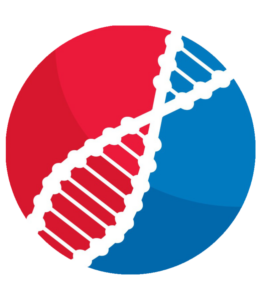 FRIEDA, collection
FRIEDA, collection
info@frieda.cz
 Rett Community - Association of parents and friends of girls with Rett syndrome
Rett Community - Association of parents and friends of girls with Rett syndrome
info@rett-cz.com
Association supporting families with Angelman syndrome
angelman@email.cz
Association of gene therapy, z.s. AGENT
info@asgent.org
Ordering of a super-council examination at the children's section of the Center for Hereditary Ataxias
The Center for Hereditary Ataxias offers the possibility of a super consultation examination for patients from all over the Czech Republic based on the recommendation of their treating neurologist or pediatrician.
In the event that you are caring for a patient with chronic cerebellar ataxia whom you wish to send to the Center, please perform a basic examination to rule out acquired forms of ataxia - i.e. a detailed anamnesis (including information regarding a three-generation family tree if possible), a clinical examination, basic laboratory tests and magnetic resonance of the brain, possibly spinal cord.
More detailed information for doctors is available here:
Hereditary cerebellar ataxia in adults
Autosomal recessive and X-linked ataxias
Autosomal dominant spinocerebellar ataxia
Ordering to the center is possible by e-mail at alena.zumrova@fnmotol.cz.
Please attach copies of previous examinations or reports from previous hospitalizations and send MR images via ePACS.
Location
The children's part of the center is located in the Faculty Hospital in Motol, on the 3rd floor of the children's polyclinic, node D, Department of Pediatric Neurology of the Motol General Hospital.
Neurogenetic laboratory
Neurogenetic Laboratory of the Department of Pediatric Neurology, 2nd Medical Faculty, Charles University and University Hospital Motol (NGL) is a highly specialized university and hospital laboratory that combines the field of medical and preventive care, research and pedagogy. The laboratory has a tradition of more than twenty years and its focus is unique at the national level. The laboratory is accredited according to the international standard ČSN EN ISO 15189.
Medical preventive care NGL focuses on the diagnosis of genetic causes of hereditary neurological diseases, in particular hereditary Charcot-Marie-Tooth neuropathy, hereditary spastic paraparesis and other neuromuscular diseases, severe childhood epilepsy, rapid and severe neurodegeneration and hereditary non-syndromic hearing disorders.
The laboratory cooperates mainly with pediatric and adult neurology clinics throughout the Czech Republic, provides laboratory services for Motol University Hospital and other hospitals in the Czech Republic, both in the field of diagnostics and treatment and research of all diseases it deals with. The laboratory has long been involved in external quality assessment within the international quality control system The European Molecular Genetics Quality Network (EMQN).
Educational activity - NGL provides undergraduate teaching of domestic and foreign students of the 2nd Faculty of Medicine, Charles University, and postgraduate teaching of doctors and universities from other fields.
Scientific research activity represents a long-term important activity of the laboratory with many outputs in the form of numerous publications in foreign impact journals. The laboratory team is a successful solver of many grants and team members have won many important awards for publishing and research activities. The laboratory is dedicated to the search for new causes of hereditary neuropathy, research into less common types of neuropathy, spastic paraparesis, severe childhood epilepsy and hereditary deafness. The laboratory has been cooperating for a long time with several important foreign workplaces (Austria, Germany, USA). Scientific activity is closely intertwined with medical and preventive activities and represents a dynamically developing form of connecting research with practice.
Provided examinations
DNA testing can be used to confirm the diagnosis, but in principle it cannot be ruled out. This rule applies to any genetic disease. The road to finding the right diagnosis is often very long, so with the patient's consent, we keep the genetic material in our laboratory for further possible examinations in the future. The neurogenetic laboratory offers genetic examinations of the following congenital diseases:
Hereditary Neuropathy Charcot-Marie-Tooth (CMT)
Hereditary neuropathies CMT (or hereditary motor and sensitive neuropathies, HMSN) are the most common hereditary neuromuscular diseases, which affect about 4 people in the Czech Republic. In patients with CMT, the strength and motility of the lower and eventually upper limbs gradually deteriorates as a result of damage to their peripheral nerves. CMT is not a deadly disease and in most cases does not shorten life expectancy. However, it often leads to physical disability. Manifestations of CMT disease are highly variable, both within and within families. He inherits all types of Mendelian inheritance. CMT diseases are caused by pathogenic variants (formerly mutations) in many different genes, and more than 100 genes associated with CMT neuropathies have been described to date.
The Neurogenetic Laboratory investigates the causes of CMT neuropathies both in the routine diagnosis of already described genes and in research in the search for new causes of this disease. We use a wide range of methods for examination (MLPA, classical sequencing of individual genes, examination of a panel of genes, whole-genome and whole-genome sequencing).
Basic genetic testing for CMT1A duplication / GNPP deletion will elucidate up to 70% of patients with hereditary neuropathy. The success of further examinations is already significantly lower and only in 20% of patients who are negative for CMT1A duplication / HN PP deletion we find the cause of hereditary neuropathy. All genetic tests are relatively expensive and time consuming. Therefore, for example, if a patient is referred to exclude the genetic cause of hereditary neuropathy and there is inflammatory CIDP in the differential diagnosis, we proceed only to the basic examination of CMT1A duplication / GNPP deletion.
The chances of elucidating the cause of hereditary neuropathy are also significantly lower in patients with late onset (after 45 years of age) and axonal type of hereditary neuropathy. In general, the chances of clarification are higher in hereditary neuropathies, where more family members are affected and this is a type of demyelinating.
For more information on available tests and investigated genes associated with CMT, see www.slg.cz.
Early and severe childhood epilepsy and epileptic encephalopathy
Severe early childhood epilepsy and epileptic encephalopathy (EE) are an extremely heterogeneous group of diseases with early onset epileptic seizures, usually drug-resistant (ie, unresponsive to treatment), accompanied by developmental stagnation or regression. The elucidation of genetic causes of such a heterogeneous group of diseases was made possible only by massively parallel sequencing (next generation sequencing, NGS). The likelihood of finding a genetic cause varies for different types of epilepsy. In rare, severe, sporadic epilepsy with onset in childhood without a pathological finding of magnetic resonance imaging of the brain, there is currently up to a 50% probability that the cause of the disease can be elucidated using genetic methods. In most cases (up to 90%) it is a pathogenic variant (formerly a mutation) newly created in the patient, with autosomal dominant inheritance. In common, albeit often familial, epilepsy, the probability of clarification is incomparably lower. The laboratory offers examinations using whole-cell sequencing with the evaluation of a virtual panel of 120 genes associated with epilepsy, or examination of the entire exoma or genome (for more information, see the documents for download or www.slg.cz). The laboratory is involved in pan-European research in this area. At present, these examinations are only covered by research grants.
Hereditary non-syndromic hearing loss (NSHL)
Hearing impairment is the least common sensory defect with a prevalence of 1:800 among newborns. More than 60% of cases have a genetic cause. Inherited hearing loss is a very diverse group, with the most common autosomal recessive hearing loss DFNB (75-80%), which is early and more severe, followed by autosomal dominant DFNA (20-25%), which is later and milder, and X-linked DNFX (1-1,5%) hearing impairment. Currently, over 100 genes are known, the causal variants of which cause hereditary hearing impairment. Up to 40% of patients with recessive hearing loss have biallelic pathogenic variants in the gene GJB2, it is a DFNB1 type. Another 5-6% of patients are clarified by the detection of biallelic pathogenic variants, mostly deletions, in the gene STRC, then it is a DFNB16 type.
The laboratory offers Sanger sequencing of the gene GJB2. It also offers testing of the STRC gene using the MLPA method, which is the second most frequently affected gene in patients with HL. Furthermore, we offer an examination of the gene panel, which contains genes so far associated with autosomal recessive, dominant and X-linked hereditary hearing impairment. The investigation is performed using NGS by evaluating a virtual panel of these genes from exome sequencing (ES) data. The laboratory also offers examination of prevalent variants that occur in the Roma population, namely in genes MARVEL 2 a MANBA.
Hereditary spastic paraparesis / paraplegia
Hereditary spastic paraparesis / paraplegia (HSP or SPG) is a heterogeneous group of inherited diseases that are clinically manifested by gradually worsening bilateral spasticity (stiffness, convulsions) and weakness of the lower limbs. The disease does not shorten life expectancy, but can lead to loss of the ability to walk independently. Symptoms of the disease can begin at any age. The disease can be caused by pathogenic variants (formerly mutations) in many genes, more than 100 of which have been described so far, with all types of inheritance. In some types of HSP, patients may gradually develop other clinical features, such as atrophy of parts of the brain, optic nerve atrophy, cognitive deficits, and more.
As part of the research, the laboratory offers examinations using whole-genome sequencing with the evaluation of a virtual panel of all genes associated with hereditary spastic paraparesis, whole-genome sequencing and MLPA examinations of selected genes (for more details see documents to download or www.slg.cz).
Note separate routine examination of the most common type of SPG4 (caused by pathogenic variants of the gene FEED OFF) Sanger sequencing does not perform the laboratory (available in laboratories GENNET, sro.).
Nijmegen breakage syndrome (NBS)
Nijmegen breakage syndrome NBS, also known as Seeman II syndrome, is a rare syndrome of chromosomal instability, more common in the Slavic population. Clinical manifestations include severe congenital microcephaly, prenatal and postnatal growth retardation, immunodeficiency, recurrent respiratory infections prone to bronchiectasis, and developmental malignancies in childhood. After the age of 3, characteristic facies develop with prominence of the middle cheeks and nose, receding low forehead, and large auricles. The syndrome is autosomal recessively inherited. In the Slavic population, the high frequency of vectors (approximately one hundred to one hundred and fifty) is the most common pathogenic variant c.657del5 in the gene NBN. Gene, resp. the protein encoded by this gene is responsible for repairing chromosomal breaks after ionizing radiation. Patients with NBS should be strictly protected against such radiation (X-rays, other mutagens). If malignancy develops, which is unfortunately very likely in patients with NBS, a reduced dose of chemotherapy should be treated and the use of radiomimetic cytostatics should be avoided. Variant testing is performed in patients with microcephaly, in families with an increased incidence of malignancies, as well as in workers at high-risk workplaces (X-rays). The laboratory offers an examination of the most common variant c.657del5 in the gene NBN fragmentation analysis. (see Downloads or www.slg.cz).
Congenital cataract, facial dysmorphism and demyelinating neuropathy syndrome (CCFDN)
CCFDN stands for congenital cataract, facial dysmorphism and demyelinating neuropathy. The disease first and always manifests itself in congenital cataracts, microcornines and microphthalmos. In the further course, there is a noticeable delay in motor and mental development. During childhood, the typical features of the face gradually develop with a prominent middle part of the face, swelling of the soft tissues of the lips and microorganisms. Neuropathy is progressive and affects the lower limbs first. During childhood and adolescence, upper limb and spine injuries are added (scoliosis, mostly severe) and the disease gradually leads to skeletal deformities. Central nervous system involvement is manifested by mild to moderate non-progressive cognitive deficits. Another feature of CCFDN is smaller growth. CCFDN syndrome has so far been observed exclusively in the Roma population and only as a result of a single pathogenic variant c.863 + 389C> T in CTDP1 gene. CCFDN is an autosomal recessive type of inheritance, ie. both parents are asymptomatic carriers of one pathogenic variant. The effect of the founder is assumed in the Roma ethnic group.
The laboratory offers variant testing in patients with clinical symptoms of CCFDN (congenital cataract, delayed psychomotor development, Roma ethnicity) using classical (Sanger) sequencing. (see Downloads or www.slg.cz).
Pelizaues-Merzbacher disease (PMD)
Pelizaeus_Merzbacher's disease (PMD), a disease characterized by a disorder of myelination of the central nervous system. Manifestations of the disease are nystagmus from birth (present in all patients), hypotension, delayed psychomotor development, spastic quadruparesis, and later in sedentary ataxia, tremor and diffuse changes on MRI images. According to the severity of the symptoms, we distinguish several forms of the disease, from the mildest through the classic form of the disease to the very severe connatal (arising during intrauterine development). Patients with a mild form of the disease do not have a shortened life expectancy, patients with the classic form of the disease sometimes live to the sixth decade of age and patients with the most severe form of the disease die in the first decade of life.
PMD is inherited X in a recessive way, which means that boys are mostly affected, women are in most cases only carriers of the disease. Diseases are caused by variants in the gene PLP1 lying on the long arm of the X chromosome. PLP1 the gene can be affected by several types of pathogenic variants (most often duplication of the whole gene and the adjacent region, point variants and other types of pathogenic variants are rarer). The severity of the disability depends on the type of causal variant. In the laboratory, we test both the most common cause of the disease using MLPA or quantitative fluorescence PCR, and point variants PLP1 gene using classical sequencing. DNA diagnosis can confirm the diagnosis of PMD, but in principle it cannot be ruled out. In the case of a patient's family with a known pathogenic variant, it is possible to perform a prenatal examination if interested. It is also possible to test women at risk for the presence of a pathogenic variant in the families of a patient with a known pathogenic variant. (see Downloads or www.slg.cz).
Emery-Dreifuss muscular dystrophy
Emery-Dreifuss muscular dystrophy is a disease characterized by three main clinical symptoms: muscle weakness, contractions of the elbows and Achilles tendons, and heart involvement in the sense of arrhythmias, atrioventricular blocks, and cardiomyopathy. It usually begins in childhood or adolescence. EDMD is as severe as other forms of muscular dystrophies and can shorten life expectancy. Early diagnosis is very important for the necessary treatment of heart disease in patients (the need for pacemaker implantation). There are forms with different types of heredity, in the Neurogenetic Laboratory we offer an examination of the cause of an autosomal dominant inherited type of disease caused by pathogenic variants in the gene LMNA. (see Downloads or www.slg.cz).
Myotubular myopathy (MTM)
Myotubular myopathy is a serious, mostly early lethal disease, severe hypotension and weakness are evident after birth, a large number of patients have respiratory weakness and need ventilation support. A muscle biopsy is characterized by centrally located nuclei. The disease is caused by pathogenic variants in the gene MTM1which is located on the X chromosome. Thus, the disease is transmitted in X-recessively bound manner, which means that only male individuals are affected. Women are asymptomatic carriers without clinical problems. Myotubular myopathy is a rare disease with an incidence of 1: 50 boys born. The laboratory offers the possibility of gene testing MTM1 MLPA methods and Sanger sequencing. (see Downloads or www.slg.cz).
Pontocerebellar hypoplasia type1 (PCH1)
Pontocerebellar hypoplasia is a group of rare inherited diseases, of which 8 types have been described. Type 1 (PCH1) is manifested prenatally or early postnatally by weakness, hypotension and respiratory failure, which leads to death before the age of 1. Magnetic resonance imaging shows marked hypoplasia of the cerebellum and pontoon.
In the laboratory, we examine the gene EXOSC3which is responsible for PCH1 in up to 30% of patients. Specifically, we are investigating the prevalent Roma variant c.92G> C, p.Gly31Ala, which is the cause of PCH1 in the Roma and comes from an ancient common ancestor. If interested, we can examine the entire coding area EXOSC3 gene. (see Downloads or www.slg.cz).
Malformation of cortical development
Malformations of cortical development (MCD) represent a wide group of congenital brain defects, especially of the cerebral cortex, but also of subcortical structures and the cerebellum, which can be clinically manifested from the fetal period with the maximum occurrence of symptoms in infancy. Patients with MCD come to the first examination for epileptic seizures, psychomotor development delay, muscle tone disorders, feeding disorders, atypical head circumference and others. In addition to medical history and physical examination, the gold standard for diagnosing patients with MCD is, in particular, high-quality magnetic resonance imaging (MRI) evaluated by an experienced neuroradiologist. Bilateral MCD most often arise as a result of pathogenic variants in one of the genes for the cytoskeleton, which encode proteins responsible for the movement of the nucleus and cytoplasmic protrusions during neuronal migration, proteins functioning as molecular motors for axonal transport, and others. Focal MCD arises on the basis of pathogenic somatic variants in the genes of the MTOR signaling cascade and their regulators. A specific group is represented by patients with pathogenic variants in the genes of the GATOR1 complex (DEPDC5, NPRL2, NPRL3), who may have focal epilepsy without finding focal cortical dysplasia (FCD) or may have focal epilepsy and definite FCD on MRI – in these patients, epilepsy often runs in families. Genetic examination is also of great importance in patients with focal pharmacoresistant epilepsy who come for examination in the epilepsy surgery program. It helps us distinguish selected patients with genetically determined focal epilepsy, in whom resection epilepsy surgery is not indicated, from patients with MRI-negative FCD, who, on the contrary, may benefit from surgical treatment of epilepsy.
The laboratory offers examinations using whole-exome sequencing with evaluation of a virtual panel of genes associated with epilepsy, or examination of the entire exome or genome. The laboratory is involved in Czech and European research grants, which also cover a substantial part of the costs of these examinations.
Autism spectrum disorders
Autism spectrum disorders (ASDs) represent a group of neurodevelopmental disorders characterized by impairments in social interactions, communication, and stereotypical, repetitive patterns of behavior, interests, and activities. The current prevalence of autism spectrum disorders is estimated at up to 2,5%. The causes of PAS are complex, with the presence of both genetic factors and environmental factors, but they can also be part of a number of diseases with a known genetic etiology. They are genetically very heterogeneous and can be caused by both inherited and newly arisen variants. In the past decade, hundreds of genes that contribute to the disease have been identified. However, these genes account for only 10-20% of PAS cases, and patients with similar pathogenic variants can be diagnosed at very different levels of the spectrum.
The laboratory offers examination of a group of genes associated with autism spectrum disorders and mental retardation. The investigation is performed using NGS by evaluating a virtual panel of selected genes from exome sequencing (ES) data.
Reception of samples for laboratory examination
We accept the following types of samples for genetic testing:
- isolated DNA
- non-coagulated blood collected in an EDTA collection vessel
- saliva collected in the ORAGENE collection container (can be provided by the laboratory on request)
Samples are accepted together with the request and informed consent of the patient (see Documents to download). All types of received samples can be stored until delivery at room temperature (preferably in the refrigerator). The receipt of biological material takes place on working days during the laboratory's operating hours via regular mail or a personally authorized healthcare professional. Samples must be properly secured against mechanical damage and contamination. The laboratory itself does not ensure the collection of biological material.
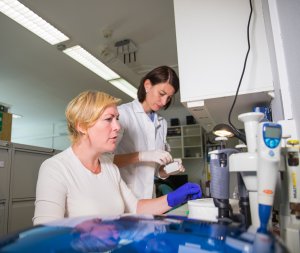 Laboratory opening hours: Mon - Fri 8:00 - 15:30
Laboratory opening hours: Mon - Fri 8:00 - 15:30
Phone: 22 443 6788, 22 443 6789
Address: Njegoševa 198
Igalo
Neurogenetic laboratory
Department of Pediatric Neurology, 2nd Faculty of Medicine, Charles University and University Hospital Motol, building 23
In Úval 84
150 06 Prague 5 - Motol
The laboratory is located in building 23 (New Oncology) on the premises of the Motol University Hospital.
Documents to download
Accreditation certificate
Contact
Neurogenetic laboratory
Department of Pediatric Neurology, 2nd Medical Faculty, Charles University and Motol University Hospital, building 23
In Úval 84
150 06 Prague 5 - Motol
Telephone: 224 436 788, 224 436 789
Personal cast
Head of the laboratory
petra.lassuthova@fnmotol.cz
Genetics of hereditary neuropathies and congenital severe epilepsy
RNDr. Anna Uhrová Mészárosová, Ph.D.
Deputy Head
anna.meszarosova@lfmotol.cuni.cz
Genetics of hereditary spastic paraparesis
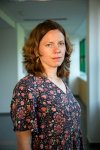
Laboratory quality manager
dana.brozkova@lfmotol.cuni.cz
Genetics of hereditary neuropathies, congenital non-syndromic deafness and rare diseases of the Roma population
Ing. Lucie Sedlackova, Ph.D.
lucie.sedlackova@fnmotol.cz
Genetics of congenital severe epilepsy
RNDr. Jan Jenčík
jan.jencik@fnmotol.cz
M.Sc. Alena Musilová
alena.musilova@lfmotol.cuni.cz
MD Barbora Lauer
barbora.lauerova@fnmotol.cz
MUDr. Barbora Benova, Ph.D.
barbora.benova@fnmotol.cz
You can find the seminars of the Department of Pediatric Neurology fall 2023 <a href="https://cdn.shopify.com/s/files/1/1932/8043/files/Odstoupeni_od_smlouvy_EN.pdf?v=1595420299" data-gt-href-en="https://en.notsofunnyany.com/">HERE</a>.
Successes of the clinic on the website of the 2nd Faculty of Medicine
Activities of the clinic in 2022
- Internal grants for 2022 (34 KB)
- Annual Report 2022 (738 KB)
The Department of Pediatric Neurology of the 2nd Medical Faculty of Charles University and the Motol University Hospital has been helping for 50 years
- Press release on the occasion of 50 years of KDN (152,35 KB)
Activities of the clinic in 2020
- Annual Report 2020 (726,31 KB)
- Internal grants for 2020 (3,05 MB)
Activities of the clinic in 2019
- Annual Report 2019 (792,53 KB)
- Internal grants for 2019 (3,28 MB)
Accreditation of the PPMD Neuromuscular Center
The neuromuscular center was accredited by the Parent Project Muscular Dystrophy (PPMD), the first in Europe.
Activities of the clinic in 2018
- Annual Report 2018 (564,39 KB)
- Internal grants for 2018 (2,61 MB)
Donation account
We accept any donations on the basis of a donation contract issued by the clinic's secretariat (224 433 301 or e-mail: alena.skrabankova@fnmotol.cz) in cooperation with the Legal Department of the University Hospital in Motol.
Account number: 50008 - 17937051/0710, Czech National Bank
vs 2119
Thank you Mr. Pavel Jech and the company JECH CZ sro for the renovation of folding chairs to accompany our patients.
During the COVID-19 epidemic, we were supported by:
- Mrs. Marie Maulis
- MD Jana Kabelkova
- Ing. Jana Hlavacka
- Mrs. Veronika Strnadová
The Department of Pediatric Neurology in 2023 was supported by:
- Ing. Martin Hrubes
- The company FREKOMOS sro
- Boheminium Mariánské Lázně, sro
The Department of Pediatric Neurology in 2022 was supported by:
- INTAX, spol. s.r.o
- pi. Martina Lovčíková
- JUDr. Daniel. Křížková
- Life for children ops
- Ing. Ivan Heczko
The Department of Pediatric Neurology in 2019 was supported by:
- Jan Bart
- Ing. Tomáš Jeník - DESIGNER
- The company FREKOMOS sro
- Milan Zařicky
- M.Sc. Daniela Saifrtová
- The company DRAKO Investment, sro
- The company VAVRUŠKA production sro
- Company KRBY - KURKA
- Students of the 2nd Faculty of Medicine, Charles University (article on the website of the 2nd Faculty of Medicine)
Thank you very much to all donors!
Contact
Adress
Department of Pediatric Neurology, 2nd Faculty of Medicine, Charles University
V Úvalu 84
Prague 5
150 06
Secretariat of the Motol University Hospital
Alena Skrabankova, DiS.
Phone: 224 433 301, e-mail: alena.skrabankova@fnmotol.cz
Bc. Zuzana Petova
Phone: 224 433 304, e-mail: zuzana.petova@fnmotol.cz
Secretariat of the 2nd Faculty of Medicine, Charles University
Renata Todtová
Phone: 224 433 302, e-mail: renata.todtova@lfmotol.cuni.cz
The secretariats are located in the building of the Children's Hospital, 3rd floor, node D
Ambulance:
Tel: 224 433 834
Nurse 3. B:
Tel: 224 433 335
Nurse 3. C:
Tel: 224 433 334
